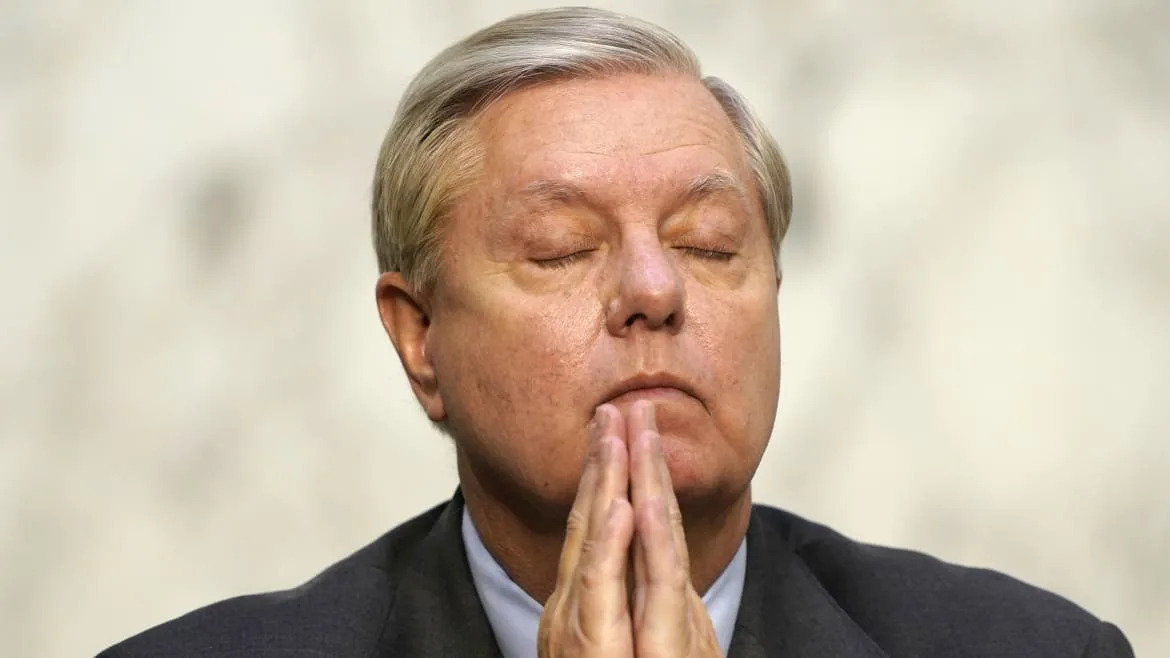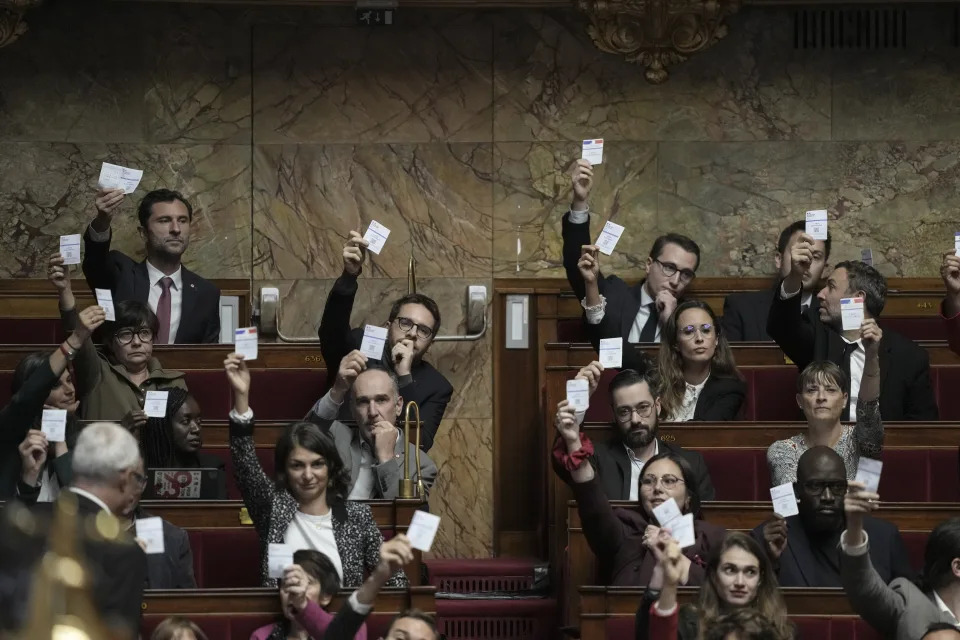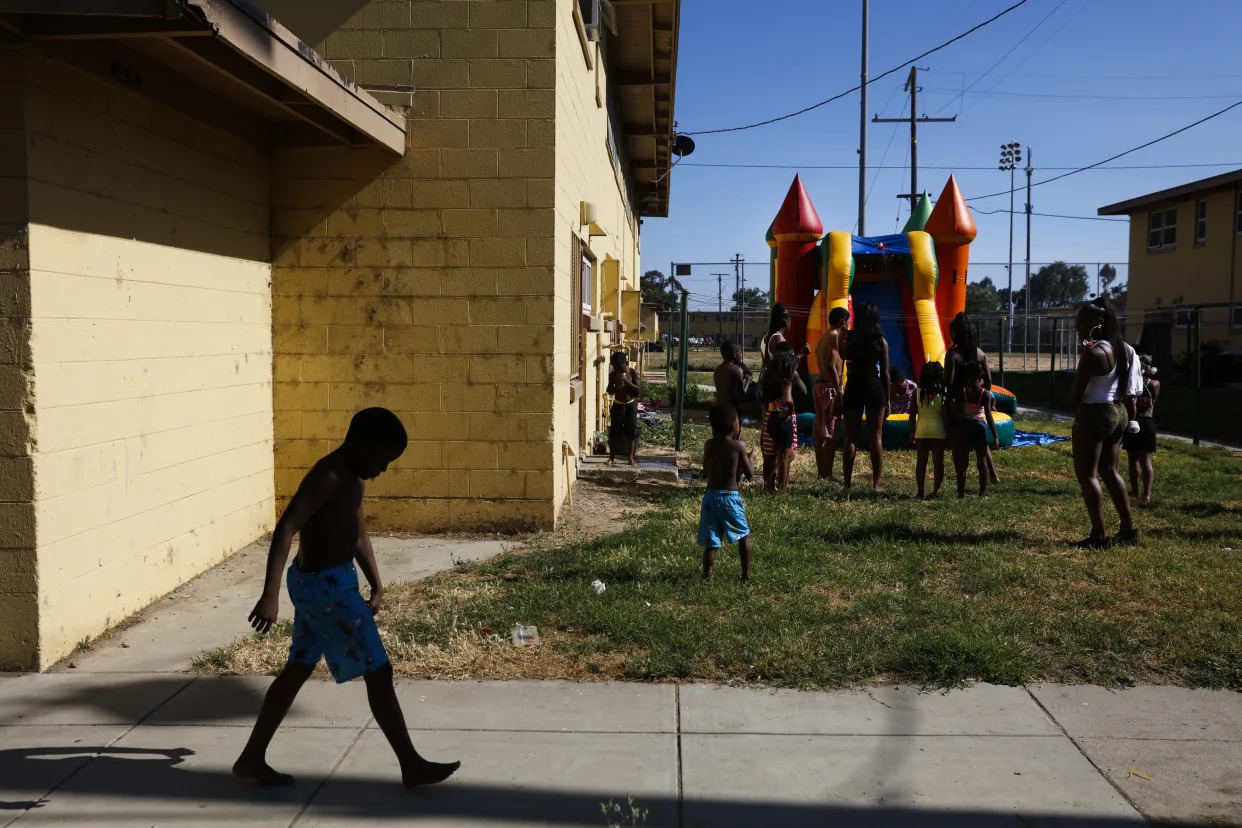America Is So Ready for Kamala Harris
Imagine, for just a moment, if Kamala Harris’s supporters were prone to the sort of political idolatry that characterizes Donald Trump’s devotees. It’s a thought experiment suited to an election for which the word historic feels inadequate to capture either Harris’s political ascent or the sheer number of unprecedented events that led to it. There is the aberration of Trump, the twice-impeached, feloniously convicted, rape-adjudicated former president—a bitter old racist returned for a third time to usher in the white supremacist autocracy that his attempted coup failed to. In any election, President Joe Biden’s age and enfeeblement since taking office would have been an issue of concern, but under the threat of Trumpism, Biden’s disastrous debate performance jettisoned the false narrative that he alone was a bulwark for democracy. Harris—elected in 2020 as the first woman, first Black, and first South Asian vice president because her résumé of legislative and prosecutorial public service made her uniquely suited for the job—should have been recognized as a better candidate than both of those men from the start. And yet, as Biden’s post-debate numbers waned and Trump’s bandaged ear crystallized his MAGA martyrdom, but her unpopularity became a tired echo of 2016’s but her emails. The commentariat, which began sowing doubts about Harris’s viability nearly as soon as she assumed the vice presidency, even floated other names for consideration as Biden’s exit became increasingly probable. Minyon Moore, chair of the Democratic National Convention, said she watched with “fascination” as the media spun a tale she always knew was divorced from reality.
“The rules dictated a lot. What they did not understand was the rules,’’ Moore told me. “First of all, she campaigned for two years with Joe Biden. She raised money for Joe Biden. She took no shortcuts. What they were trying to do was put in place a process that did not exist…. Those 4,000 delegates literally voted for Joe Biden—but they also voted for his ticket. And she was a part of that ticket.”
When Biden, a record-breaking 107 days before the election, finally left the race and endorsed Harris, the act unexpectedly unleashed an outpouring of enthusiasm and joy, emotions rarely associated with politics in recent years. The mood shift not only proved Harris’s naysayers wrong but also revealed how Biden’s frailty and Trump’s darkness had drained the party to sepia tones. Harris’s run, quite unexpectedly, infused it with color and light again. If the left had the same sanctification tendencies as the Trumpian right, the improbable events leading to Harris’s nomination might have been cast as divine intervention—Jesus taking the wheel, only to hand the keys to Harris, so she might steer America away from Trumpism and back onto a righteous road.
But the Democratic Party is not a cult of personality, a fact proved by Biden’s withdrawal. Harris’s run produced a jubilance incomparable to anything seen since at least Barack Obama’s first run, and it may even have eclipsed that. Within hours of becoming the presumptive nominee, Harris was buoyed by organizers who had begun laying the groundwork for her run years before. A Zoom organized by Win With Black Women drew 44,000 participants, an unprecedented number that required the site’s engineers to increase capacity. The call ultimately raised $1.5 million in just three hours. At least a dozen other calls followed—South Asian Women for Harris, Win With Black Men, White Women: Answer the Call—each enlisting volunteers and strategizing for a Harris win. In mid-September, Voto Latino reported a 200 percent surge in its voter registrations since the day Harris replaced Biden. A senior analyst at TargetSmart, a data research firm, reported that registrations are up more than 85 percent among Black voters overall and a staggering 98 percent among Black women. Potential youth voters increased most impressively. In 13 states, registrations have gone up nearly 176 percent and 150 percent among 18- to 29-year-old Black and Hispanic women, respectively. Taylor Swift’s much-anticipated endorsement of Harris, which came moments after Harris thrashed Trump in the debate, drove “a 400 or 500 percent increase” in people going to vote.gov to register, according to a TargetSmart analyst. What’s more, young Democrats are 14 percent more enthusiastic about voting than their Republican counterparts. While party killjoys such as David Axelrod suggested Democrats were feeling “irrational exuberance,” and James Carville chastised their “giddy elation,” organizers were getting down to work and galvanizing people to get Harris elected. Those on the ground, doing the real heavy lifting, helped consolidate support for Harris, building a campaign powered not from the top down, but from the grassroots up.
How Harris Seized Her Moment
Of course, none of this would have happened if Harris hadn’t proved herself so ready to meet the moment. First and foremost, she and her team did a masterful job of staying out of the way while Biden deliberated. Even as rumors swirled around her, Harris kept her head down and remained “completely loyal to this administration,” to quote Moore. There were no leaks that suggested she was secretly angling for the boss’s job, no little hints that she wanted to push the old guy down the stairs. And then, on Sunday, July 21, after Biden’s announcement, Harris hunkered down with her team, working her way through a who’s who list of Democratic bigwigs. Within the first 10 hours, she had made roughly 100 calls, per The New York Times, nailing down endorsements and support from former presidents, members of Congress, and labor union and civil rights players from the Democratic coalition. Some of those relationships had likely been forged over the last year, during which Harris led administration outreach efforts on LGBTQ rights, gun reform, and Black civil and voting rights, and as she engaged with young voters on college campuses. Even before Roe v. Wade was struck down by the Supreme Court’s conservative supermajority, Harris had become recognized as a forceful defender of reproductive freedom, attending abortion rights rallies and even becoming the first sitting vice president to visit an abortion clinic.
On Sunday, July 21, after Biden’s announcement, Harris hunkered down with her team, working her way through a who’s who list of Democratic bigwigs. Within the first 10 hours, she had made roughly 100 phone calls, nailing down endorsements and support from former presidents, members of Congress, and labor union and civil rights players from the Democratic coalition.
Aimee Allison, founder of She the People, an organization dedicated to helping elect women of color, emphasized Harris’s role as a liaison to those marginalized communities. “Her presence in the White House has been critical for constituencies who, frankly, didn’t have much access during Trump’s years. She made sure to play a very important convening role, welcoming groups who now are coming forward as part of the Kamala Harris coalition, organizing themselves,” Allison told me. “The respect that she’s shown to many, many groups—and she’s now seeing the results of this kind of politicking.”
It would be absurd to ignore the all-hands-on-deck efforts of a massive, dedicated Democratic machine working at full capacity to ensure a flawless transition. But Harris, during what one veteran strategist labeled “a perfect 48 hours,” deserves credit for stewarding the ship and keeping the operation steady. “The seamlessness of Ms. Harris’s ascent,” the Times reported, “impressed a range of party leaders after years of private sniping and second-guessing of her political skills.” Not for the first time, an underestimated Harris demonstrated a level of agility, skill, and savvy in keeping the campaign running with nary a misstep. Choosing Minnesota Governor Tim Walz as her running mate was yet another canny move.
Just as the inside game was expertly played, the outside game, the part visible to the electorate, may have been even stronger. Much has been made of Harris’s rallies—the lines forming hours before start time and snaking for blocks, the exuberant multiracial crowds dancing to music from the last decade (for which Harris-Walz campaign will not be sued), the supporters who appear rapt instead of driven to “exhaustion and boredom.” Yes, size matters, but not in the way Trump thinks. It’s a sign that momentum is on Harris’s side. But it’s also a testament to how her candidacy has brought together a diverse swath of voters who share an eagerness to get beyond the toxic divisions that have plagued the country since the rise of MAGA. For nearly a decade, Trump’s rallies have been hate contagions, their poisonous us-versus-them serum infecting the entire body politic. It’s been such a relief to witness the palpable joy of Harris’s audiences, a reflection of the campaign’s tone—a kind of uplifting feedback loop between the candidate and her supporters. A Harris presidency offers the opportunity to step out of the darkness of Trumpism into a sunny, expansive future that welcomes all. It’s the difference between staring mournfully backward and looking hopefully ahead, a task anathema to an embittered Trump, and one that a well-meaning but aged Biden could not quite muster the energy to pull off.
The very idea of patriotism is transformed when advanced by a Black, biracial daughter of immigrants. There is a sense that what is actually being invoked is the progressive idea that this country belongs to all of us. The right-wingers don’t own patriotism. The flag, the chant, and the ideals they represent were never theirs alone to define.
In articulating their vision for the country, Harris and Minnesota Governor Tim Walz have moved rally and conventiongoers to wave U.S. flags and chant “U-S-A, U-S-A,” normally a rarity at Democratic events. Republicans have long taken a proprietary approach to the ideas of freedom, liberty, and patriotism, treating them as property rather than principles, wielding them like empty slogans with brand value (when you use the word “freedom” so promiscuously that you rename french fries “freedom fries” in congressional cafeterias, as GOP lawmakers did briefly after 9/11, you’ve cheapened a valuable word). Those chants and flags carry a completely different resonance at Harris’s rallies than when they are invoked, and weaponized, by MAGA throngs. The very idea of patriotism is transformed when advanced by a Black, biracial daughter of immigrants. There is the sense that what is actually being invoked is the progressive idea that this country belongs to all of us. The right-wingers don’t own patriotism; in fact, they have presented a corrupt and exclusionary version of it. The flag, the chant, and the ideals they represent were never theirs alone to define. There’s something deeply powerful in reclaiming these symbols—in showing they can represent a diverse, forward-looking vision of the country rather than just a nostalgic one. This is a genuine show of patriotism—neither jingoistic nor nationalistic, but rooted in a deep love for the country and the belief that there is still work to be done.
“I’m of the notion that you can love something, critique it, and help to make it better, all at the same time. I think that has often been Black America’s relationship with America. We love our country just as much as anybody else, but we’ve often had to ask the question, does our country love us the same?” Jotaka Eaddy, founder of Win With Black Women, told me. “In this moment, we feel that, at least as it relates to breaking and shattering the barriers related to our representation, I think we’re continuing to see those barriers broken.”
She cited Langston Hughes’s famous poem I, Too, published in 1926—during the Harlem Renaissance, but long before Black Americans, even in New York City, enjoyed anything close to equality:
I, too, sing America.
I am the darker brother.
They send me to eat in the kitchen
When company comes,
But I laugh,
And eat well,
And grow strong.
Tomorrow,
I’ll be at the table
When company comes.
Nobody’ll dare
Say to me,
“Eat in the kitchen,”
Then.
Besides,
They’ll see how beautiful I am
And be ashamed—
I, too, am America.
“I think we, too, sing America,” Eaddy told me.
Generational Change and the Politics of Boomerism
Perhaps a factor in the excitement accompanying Harris’s rise is the sense that her candidacy may usher in a long-awaited generational shift in Democratic politics. Loosening the viselike grip of gerontocratic boomerism has also proved that there is an updated way campaigns can be run. If the 2016 election was all about how the “left can’t meme”—the mantra of alt-right shit-posters and 4chan edgelords who helped elect Trump—the 2024 election so far has been about Harris dominating the internet. From the outset, the campaign has made smart decisions, embracing the coconut memes and lime-green Brat color schemes. Its Taylor Swift–inspired friendship bracelets, made available shortly after the singer’s endorsement, quickly sold out. It’s funny to think that, should Harris win the election, Republicans will deserve just the teeniest nano-bit of credit for helping her get elected. It was the Republican National Convention, after all, that repackaged old clips of Harris in an effort to embarrass her. Instead, those images of Harris laughing and quoting her mother humanized her, before Trump’s racist and sexist attacks could begin to corrupt her image.
It goes beyond coconut memes. Consider how videos of Harris and Walz chatting about beloved albums and taco recipes did more to provide a portrait of the candidates on their own terms than so many Republican talking points disguised as gotcha interview questions. In the early days of the shortest U.S. presidential campaign in modern history, the pair’s ability to present themselves directly to voters was an incredible asset. That’s not to say Harris can ride social media alone to a win, but it’s certainly better than passively leaving the task to the media. Perhaps it took a campaign headed by a woman who was born after the invention of color television and Hula-Hoops, and who first won elective office in 2003, as the internet age was bursting into full flower, to understand the true direct-to-voter value of social media. Obama, also born after rock and roll was invented, is often called “the first social media president,” a label that fits to a certain degree. But during his inaugural and incumbent runs in 2008 and 2012, no social media sites had the audience or influence enjoyed by platforms today. Roughly 170 million Americans are currently on TikTok, which is used by almost two-thirds of Americans younger than 30, Pew Research reports, and nearly 40 percent of Americans under age 50. Both there and on the platform formerly known as Twitter—which since Elon Musk’s takeover has become a cesspool of right-wing misinformation, bots, and talking points too vile to dignify here—the KamalaHQ account trolls Trump, slices up humiliating Trump and JD Vance clips to repurpose as campaign ads on the fly, fact-checks Trump’s debate lies, boosts its favorable news content, and does a far better job than the mainstream media does of highlighting the madness of Trump and his MAGA acolytes in real time.

Illustration of Kamala Harris
It’s inspiring to see a Democratic Party that’s finally stopped volunteering its lunch money to bad-faith actors and insecure clowns. Likewise, the Harris team’s trolling of Trump online, and her face-to-face IRL baiting of his insecurities—demonstrated with such aplomb at the debate—have been delightful to watch. Calling Trump “dangerous,” “a bully,” or “a strongman” only emboldens him. He’s been curating an image as a tough guy since the 1980s, and he thrives, above all else, on being feared. But Trump isn’t powerful or strong. He’s a trust fund kid from Queens who weaponized his daddy issues into everyone else’s problem. Elevating him to strongman status only played into MAGA’s Trump-aggrandizing game. Perhaps a generation of Democrats from another era remain obsessed with civility, but sometimes you have to meet your opponents where they are—on the low road, where they’ve built a detour to electoral wins. Get on that road, knock them off it, and make sure you snap a pic of them falling so you can caption it and share it on your socials.
Harris seems to get this; hence the green light she’s given to a crack team of Gen Z staffers, who have approached attention-grabbing so differently than Biden did. Her campaign knows, for better or worse, that this election is about playing the attention game—a game Trump essentially created in his own image. Beating him at it is critical. Harris can’t meme her way to victory, but we’ve reached a point where capturing the American public’s attention is, in itself, a key part of winning. Part of that is knowing how to navigate online culture—and, more importantly, knowing how to push back hard when necessary, and using the digital town square to your advantage. For the first time, this year’s DNC credentialed more than 200 digital content creators. Among these was Brandy Star Merriweather, founder of BStarPR and a social media influencer who has used her platform to help engage fellow Gen Zers with Harris’s campaign.
“I love that the memes have been able to reach a demographic who may not be involved in politics or care to read it, but then they can look at a meme and kind of understand.... It’s beneficial to people who may not be in that world all the time hearing about policy,” Merriweather told me. “They are breaking down solutions in a way that anyone can consume. And I think doing it on social media, we’re quick—we love things quick, we love things that are pretty funny and witty. I’ve not seen a candidate do that before.”
Finally, the campaign’s approach on all these fronts is different from its predecessors because the electorate—the important question of who now constitutes “the people”—is different. In some ways, quite literally. An estimated 20 million baby boomers have died over the last eight years. In the same period, around 32 million young people have come of voting age, with nearly half of Gen Z voters identifying as people of color. This is a country that has grown Blacker, browner, and gayer than it was in 2016, the last time a woman appeared at the top of the ticket. The white backlash that has defined the era since Trump arrived has been challenged by progressive activism including #MeToo, Black Lives Matter, and the kind of women-led political organizing that helped elevate Harris’s candidacy.
All this is to say that while the country may not be as far along as many of us would hope, it is in a different place than it was eight years ago. If Harris has not touted her “firstness” as much as Hillary Clinton did, it is perhaps because she does not have to. The convention-breaking nature of her candidacy is apparent both in who she is as an embodied person and in what she stands for in terms of politics, morals, and outlook. Harris is able to personalize messaging about abortion, civil rights, gender equality, and more far better than Biden ever could. She represents so much more accurately who this country is today. We don’t need to yearn for a fictional yesteryear—to make America great again—because this is a better America we live in NOW.
Black Women Make History
America may very well be “the greatest democracy in the history of the world,” as Harris declared at the convention, but our democracy has also been terribly flawed by a legacy of exclusion and, often, plain old cruelty and sadism. The Founding Fathers’ so-called democratic vision was myopically limited by both white supremacy and patriarchy. And while we have made slow, painful steps toward inclusive democracy, each advance has been met by violent opposition and retrenchment. In nearly 250 years of American history, only one white woman has clinched a major party’s nomination, and the procession of white males into the Oval Office was disrupted by a Black man only once. Trump, in fact, was elected president by those seeking reassurance that Obama’s presidency neither heralded a turn to multiracial democracy nor diminished the enduring privileges of white mediocrity. In the split screen that was so often on display during the September 10 debate, Harris’s assured competence, in contrast to the sputtering incompetence of Trump—a man who after nine years could only hold up the “concepts of a plan” like so much sand running through his fingers—was a perfect encapsulation of a Black woman being twice as good as a white guy to get the same job.
Harris is no stranger to these presumptions. Amid the veepstakes of 2020, she was criticized as “too ambitious” for the role, which is another way of saying she “didn’t seem to know her place.” A mere six months into her vice presidency, outlets including Business Insider, The Washington Post, and Politico began publishing articles depicting the vice president as “a bully” who wasn’t diligent enough “to do the prep and the work”—but also—an “over-prepared” perfectionist who “berated” staff who didn’t meet her lofty standards. (One Biden staffer called it “a whisper campaign designed to sabotage her.”) An op-ed from The Hill written way back in November 2021 claimed she’d be “a 2024 problem for Biden and the Democrats,” calling her “an unpopular sharp-tongued incumbent female vice president.” And just recently, The Washington Post ran a piece suggesting that a potential shortcoming for Harris was her “demanding management style,” including her prosecutorial habit of “asking pointed questions” of staff. This included a former staffer’s lament that it was “stressful to brief her, because she’s read all the materials, has annotated it, and is prepared to talk through it.” You cannot imagine these criticisms lodged against a man because that is not a thing that happens. Make America Competent Again, I say.
Harris’s candidacy and her effort are in keeping with the persistent resolve of Black Americans—particularly Black women—to push America toward fulfilling its democratic ideals. It was Win With Black Women, a collective of prominent Black women formed in 2020 to elevate the image of Black women and support their pursuit of political office, that got the fundraising ball rolling, encouraging the parade of affinity groups that followed. Some moments have even seemed imbued with historical resonance. The night of August 22, when Harris appeared at the Democratic National Convention to accept the presidential nomination, marked 60 years to the day that civil rights activist Fannie Lou Hamer delivered a blistering and rule-changing speech at the 1964 convention in Atlantic City.
Hamer, co-founder of the interracial Mississippi Freedom Democratic Party, led the delegation to that convention to contest the seating of her home state’s all-white, segregationist delegation. In her searing testimony before the DNC’s Credentials Committee, Hamer detailed the horrific violence and abuses inflicted upon her by state-backed white aggressors for daring to vote. Hamer had been fired from her job and evicted from her home, and the Ku Klux Klan fired 16 bullets into the home where she sought refuge from the violence. (“The only thing they could do to me was to kill me,” she would tell a later interviewer, “and it seemed like they’d been trying to do that a little bit at a time ever since I could remember.”) After attending a workshop to learn how to register other Black Mississippians, she was arrested and thrown in the county jail, where she was beaten with billy clubs and sexually assaulted. She suffered permanent bodily damage, including the worsening of a limp resulting from a childhood bout with polio, a blood clot behind her eye that eventually left her nearly blind, and severe kidney damage. “All of this is on account we want to register,” Hamer noted in her speech, “to become first-class citizens.
”President Lyndon B. Johnson had already tried to muzzle Hamer through various advisers. In the middle of her testimony, he called an impromptu press conference to divert television cameras. But network news shows broadcast Hamer’s speech in full during prime time, effectively giving her a far bigger audience than if it had aired live. “I question America,” Hamer concluded. “Is this America, the land of the free and the home of the brave, where we have to sleep with our telephones off the hooks because our lives are threatened daily because we want to live as decent human beings in America?”

Hamer would be elected as a delegate to the 1972 convention in Miami, the same year that Shirley Chisholm became the first Black woman to seek a major party’s nomination. Chisholm, who like Harris was both of West Indian descent and was the child of immigrants, had been the first Black woman elected to Congress in 1968. Four years later, without waiting for backing from a Democratic Party machine she knew would never come, Chisholm launched a campaign that was both truly independent and disruptive. “I am not the candidate of any political bosses or fat cats or special interests,” she stated in her announcement speech, delivered at one of the oldest Black churches in her hometown of Brooklyn, New York. Though she had expected to run up against the commingled toxicity of anti-Black racism and misogyny, or misogynoir, Chisholm was nonetheless disappointed by the lack of support she received from the overwhelmingly white, mainstream feminist movement, or Black civil rights figures. Neither the National Women’s Political Caucus nor the Congressional Black Caucus, both groups that Chisholm had co-founded, endorsed her, essentially citing pragmatism over principles, and a desperate need to beat Richard Nixon. Notably, Hamer boasted of voting for Chisholm on the first ballot, stating, “Men couldn’t have talked about the real issues in this country the way she did. They bow to political pressure, but Chisholm didn’t bow to anyone. She’s a great person, a Black person, and a great woman, and she’s working for the kinds of change that the National Women’s Political Caucus is working for. With the woman’s vote and the youth vote—far more than 50 percent—we can have a candidate like Chisholm in the White House one day.”
Chisholm would later write in her memoir, The Good Fight: “I ran for the presidency, despite hopeless odds, to demonstrate the sheer will and refusal to accept the status quo…. The next time a woman runs, or a Black, or a Jew or anyone from a group that the country is ‘not ready’ to elect to its highest office, I believe that he or she will be taken seriously from the start…. I ran because someone had to do it first. In this country everybody is supposed to be able to run for president, but that’s never really been true.”
Harris has nodded to that lineage. In her 2020 vice presidential victory speech, she paid tribute to the “women who fought and sacrificed so much for equality, and liberty, and justice for all,” paying specific homage to Black women, “who are too often overlooked, but so often prove that they are the backbone of our democracy.” She has embraced this debt throughout her life, and it is imbued in her biography. Alpha Kappa Alphas like Coretta Scott King and Toni Morrison. Divine Nine icon Barbara Jordan. Howard alums from Zora Neale Hurston to Toni Morrison to Thurgood Marshall. Her citation of these figures, all liberatory leaders who have made this union slightly less imperfect, is recognition of the shoulders on which she, and so many of us, stand.
What Comes Next
Three weeks out from voting day, if there’s anything that this campaign should have taught us, it’s that it’s impossible to predict what the final stretch will look like. Trump is desperate, and thus capable of anything, a prospect that is terrifying but in keeping with who he has always been. Perhaps there will be missteps from Harris, who needs to strengthen her support among noncollege voters. And some major external event could derail things at the last minute.
But we know this already: America, just as Shirley Chisholm hoped, is more than ready for Kamala Harris. From its inception, Harris’s campaign has been powered by the people. The surge in voter registrations, the grassroots organizers hitting the pavement, the supporters who have filled her rallies to capacity—all of these are a testament to the movement behind her campaign, which is driven from the ground up.
This is no ordinary campaign, but it’s exactly the campaign that we needed at this extraordinary moment. In it, there is the potential for an America brought a little closer to giving everyone a place at the table. Most Americans, I truly believe, would love to see an end to MAGA. Harris, along with millions of energized supporters, has the potential to shape a more promising future. Within that, a rejection of revanchist politics, a renewed push toward progress, and full-throated assertion—yet again—that we are not going back.









 Donald Trump's economic policies would destroy economic growth, according to an expert analysis. (Peterson Institute for International Economics)
Donald Trump's economic policies would destroy economic growth, according to an expert analysis. (Peterson Institute for International Economics)